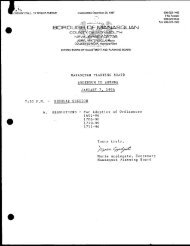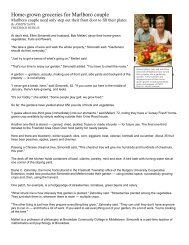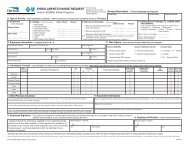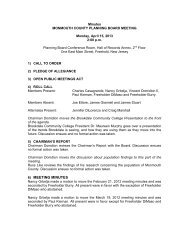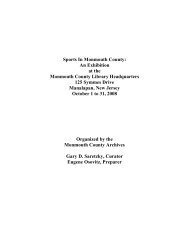NATURAL and CULTURAL FEATURES of MONMOUTH COUNTY
NATURAL and CULTURAL FEATURES of MONMOUTH COUNTY
NATURAL and CULTURAL FEATURES of MONMOUTH COUNTY
Create successful ePaper yourself
Turn your PDF publications into a flip-book with our unique Google optimized e-Paper software.
lie between the Piedmont cobble to the northwest <strong>and</strong> the coarse Kirkwood-Cohansey s<strong>and</strong>s <strong>of</strong><br />
the Outer Coastal Plain.<br />
MCHD’s Rapid Bioassessment work has uniquely identified a multitude <strong>of</strong> stream sites in<br />
glauconitic soils that are dominated by pollutant-tolerant benthic organisms that are associated<br />
with erosion <strong>and</strong> siltation. During streambank erosion, clay <strong>and</strong> silt sized particles remain<br />
colloidally suspended in the water column, prolonging turbidity. These fines blanket the<br />
streambed <strong>and</strong> smother the least hardy macroinvertebrates that live in the sediment. Additionally,<br />
streams in glauconitic soils downcut as they erode <strong>and</strong> eventually lose their ability to overflow<br />
into adjacent wetl<strong>and</strong>s. In contrast, streams flowing in the coarse s<strong>and</strong>s <strong>of</strong> the Kirkwood-<br />
Cohansey outcrop can maintain wetl<strong>and</strong> availability during 2-year, bankfull storms (3.4 inches in<br />
24 hours). They are more stable than downcut streams since they can store stormwater in the<br />
wetl<strong>and</strong>s <strong>and</strong> release it over longer periods <strong>of</strong> time. That is why the majority <strong>of</strong> Non-Impaired<br />
streams with pollutant intolerant macroinvertebrates are found in the s<strong>and</strong>y mid to southern part<br />
<strong>of</strong> the County. S<strong>and</strong>y streams like the Metedeconck even retain their excellent, Non-Impaired<br />
quality near developed areas like Route 9 in Howell, but the few Non-Impaired streams in the<br />
glauconitic outcrops are always found in undeveloped areas.<br />
The eroded clay <strong>and</strong> silt fines that blanket streambeds <strong>and</strong> lakes also adsorb pollutants <strong>and</strong><br />
nutrients more efficiently than s<strong>and</strong>, <strong>and</strong> provide habitat for the regrowth <strong>of</strong> bacteria <strong>and</strong> other<br />
microbes during the warmest months <strong>of</strong> the summer. This bacterial-laden muck will resuspend in<br />
the water column during rainfall, <strong>and</strong> has been linked to ocean beach closures near lake outfalls.<br />
As freshwater colloids enter estuaries, the increase in salinity causes these pollutant-laden fines<br />
to acquire an ionic charge <strong>and</strong> clump together into aggregates, which sink <strong>and</strong> accumulate in the<br />
estuarine sediment. It has been estimated that up to 80% <strong>of</strong> freshwater pollutants accumulate in<br />
estuaries; furthermore, “probably less than 5% <strong>of</strong> the sediment reaching the coastal zone in the<br />
Atlantic seaboard <strong>of</strong> the U.S. is transferred to the continental shelf or to the deep sea” (DePetris,<br />
1996).<br />
A general rule regarding streambank erosion is that the southern (north-facing) <strong>and</strong> eastern<br />
(west-facing) streambanks erode faster than the opposite banks because <strong>of</strong> the higher rates <strong>of</strong><br />
freezing <strong>and</strong> thawing during the winter. Occasionally erosion is significantly increased during<br />
the winter when a frozen slurry <strong>of</strong> streambank is sloughed <strong>of</strong>f after the temperature rises <strong>and</strong> it<br />
rains (Smith, 2000). Erosion from road run<strong>of</strong>f first escalated in the County with the development<br />
that followed the opening <strong>of</strong> the Garden State Parkway in 1954. For example, Lake Matawan<br />
was originally created in 1923 by damming Gravelly Creek. The lake extended to Church Street<br />
in Matawan, where an extensive wooden railroad tressel was built over the lake at nearby Water<br />
St. But because <strong>of</strong> the siltation that began in the 1960’s, the Lake ends near Little St. in<br />
Matawan, <strong>and</strong> the still-existing tressel at Water St. now crosses over wooded wetl<strong>and</strong>s instead <strong>of</strong><br />
a lake (Kisk, 2006; Starace, 2006).<br />
GLAUCONITE<br />
Glauconite (marl, greens<strong>and</strong>, rotten stone, poison marl, hardpan) is a green to black silicate <strong>of</strong><br />
iron, potassium, <strong>and</strong> phosphorous that formed from the droppings <strong>of</strong> sediment-dwelling<br />
invertebrates in the shallow regions beyond the breakers <strong>of</strong> Cretaceous <strong>and</strong> Tertiary seas<br />
(Tedrow, 1986); specifically, in a low oxygen, reduced iron environments in a specific facies<br />
array associated with silica-consuming diatom blooms in upwelling zones close to the coast<br />
(Earthscape, 2007). A modern, anthropomorphic example <strong>of</strong> glauconite formation: glauconite




